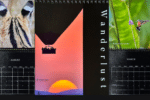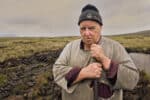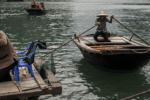
Last week there was another in the endless array of hashtag days, one dedicated to the National Geographic. It prompted me to pull out an older frame, one that has stuck to me a bit. Shot at China Lake Naval Air Weapons Station, at about 4 or 5am or so, it depicts a prototype drone, called at that time, the X-47A. The guys on the base were great, and got up early and parked this down at the end of one of the runways, and let me have at it for about two hours. I’ve written about this pic in a chapter in one of my books called, “Don’t Light It, Light Around It.” I believe that was the phrase I used. Was true then, still true now. There were lots of questions prompted by the Instagram re-visit of this pic, so here goes.
There are a total of eight Speedlights used here. Three apiece on each of the back wing flaps, and two in the front wheel well. They are all gelled with a CTO gel, warming them to a tungsten temp. They are bounced straight down onto the tarmac. What is triggering these lights are two 1×6 strips, firing out of two Profoto 7-B units, and the strips are horizontally arrayed, to match the configuration of the wings. They, as I recall, are slightly gelled, but much closer to straight up daylight. Shot on a Nikon D1-X. Most likely a lens in the realm of a 24mm. That’s it. Done deal. The tarmac bounce separates the bird from the blackness. The wing strips give the shape further definition. And I got lucky with the sky, which reflected off the metallic upper skin of the drone.
It was this job that gave rise to the Justin Clamp, or as Manfrotto calls it, the 175F-1. I was using a bunch of third party, cheeseball clamps, and my lights kept falling off aircraft. I called my bud Justin Stailey at what was then Bogen, soon to be Manfrotto, and told him my tale of woe. He brought over a bunch of bits and pieces out of Manfrotto stock, and we cobbled together what we thought would work. I wrote about it as the “Justin Clamp,” and it went into the catalog. It also, I believe, earned Justin the enmity of some of his RIT profs, as none of them apparently had a piece of gear named after them. Or at least that was what I was led to believe.
But basically, you just light the background and let the shape define itself. You hope bounce and wash and reflection light are just enough to, literally, get away with. Can be used on big scale items as well.

There’s a ton of light behind this telescope, and nearly zilch on the front of it. The binocular mirrors are being lit by the sky behind me. The scatter inside this giant box, off the walls and floor, do the job lighting up the massive interior. (This is a roughly twenty story building, and I’m triggering all this from a 175′ boom crane.
The moral of the story, is there are no rules here. Sometimes, when it comes to lighting, it’s better to start at the back, and work your way forward. Let light scatter and bounce do some of the work for you. Backlighting is a wonderful thing, especially, when the sun does it for you, and you don’t have to lift a finger, or a flash to cover that area.
Below, Ken Collins, is one of the last pilots of the SR-71 Blackbird. Used one flash. The sun took care of the rest, defining that amazing airplane shape. Light for him is a large octa. One light, up and done.

More tk….














One of my ALL TIME Faves by Joe for aviation….sexy, surreal, and sizzle.
Three great images. One great lesson. Thanks Joe.
You take the complex and make is seem easy. Thanks Joe.
Spent a year at China Lake years ago. Great duty station and magnificent scenery all around the Station.
Thanks Charles! All Best….
It’s really wonderful. So gorgeous, oh god.
The phase which has mentioned in your blog “Don’t Light It, Light Around It.” says all. And one should also follow this thing. Your blog is really helpful, thanks for sharing and keeps on posting a blog like this.
Wonderful images with lesson, Thanks so much Joe.
Lots of great advice here. Thank you
I like the light surrounding the drone, Joe. Every time I think I’ve learnt enough about photography, I see something new on your website or Youtube and then I know, my journey sill has just begun. Thank you for sharing the information.